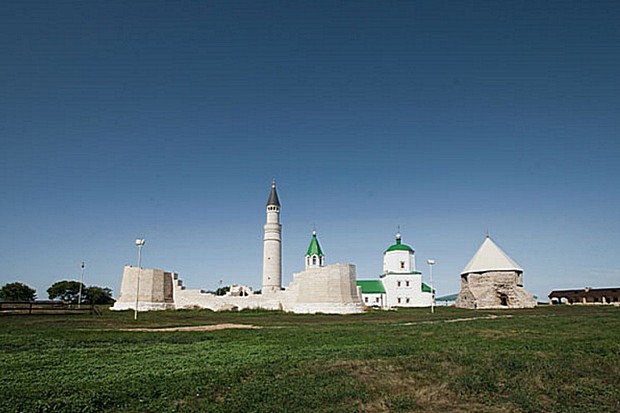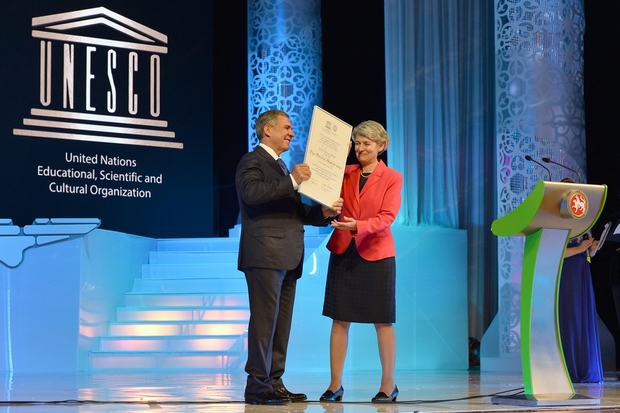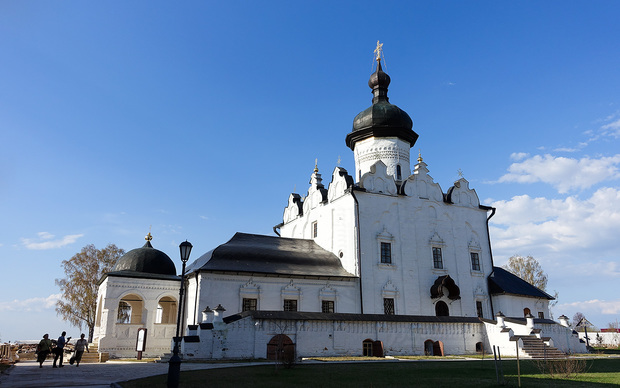How Tatarstan paves its way to UNESCO and joins Great Silk Road
Achievements of Tatarstan in UNESCO World Heritage were noted in the recent World Heritage of the CIS countries: Challenges, Problems and Solutions international congress that took place in the Moscow Kremlin. It is known that now the Kazan Kremlin and Bolgar are on the UNESCO List, and Sviyazhsk's landmarks are in line. Kazan historian, vice-rector of the Institute of Culture and scientist thanks to whom the whole world knew about the ancient fortress Rafael Valeyev told how Tatarstan paved its way to the universal recognition and further perspectives.
To make Bolgar worldwide known
Nowadays many Russian regions have a task to prepare a nomination dossier to the UNESCO World Heritage List within the framework of the Russian president's instruction. At the same time, the very selection process is getting stricter every year: the number of quotas is reduced, new requirements to the quality of nominations dossiers are created. Considering the ambitious goal, which is to have been in the top 5 leaders with the biggest number of World Heritage Sites by 2030, set in the Strategy of the State Cultural Policy of Russia until 2030, it is especially important to not only know the process of joining the UNESCO World Heritage List but also imagine pitfalls while working with experts and documents.
It is good that Bolgar Historical and Archaeological Complex has been the first Russian site to be included in the list at the 38 th session of the UNESCO World Heritage Committee in Doha for the first time since 2005. It was the first Russian archaeological site to be included in the list. During the preparation of the scientific nomination, there was a big number of scientific, research, archaeological, restoration and conservation works as well as museumification of landmarks. Compared to the first version of the nomination prepared in 1999, the content and the name changed – from 500-year-old historical and architectural to 1,500-year-old historical and archaeological complex from the Migration Period (4th century A. C.). Criteria offered by experts of the International Council on Monuments and Sites (ICOMOS) changed. The role of Bolgar was explained in a better way as a spiritual and sacral centre where Islam was officially voluntarily adopted at the state level in 922. As a result, Volga Bolgaria joined the system of the Muslim culture.
The authenticity and integrity of Bolgarian landmarks, conservation of earthworks and moats of the 14 th century, over 30 landmarks of architectural and archaeological ruins were proved, their conservation at a scientific level for our conditions in the northeast of Eurasia was carried out. The exploration of over 3% of cultural layers, use of interdisciplinary methods allowed to use non-destructive technologies while examining the Bolgarian fortress.

The positive result was mainly connected with the creation of the Foundation of Revival of Monuments of the Republic of Tatarstan, which was created in 2010. First President of Tatarstan became the chairman of the Supervisory Board. In addition, a special programme Cultural Heritage Island City of Sviyazhsk and Ancient Bolgar allowed to detect, examine, conserve and museumify the landmarks systematically and turn the Bolgarian fortress into a historical, cultural, museum, spiritual and sacral centre that stresses its remarkable universal value.
Created as early as 1969, the first museum-reserve in Tatarstan Bolgar Historical and Architectural Reserve (nowadays the republic has 9 museum-reserves, Russia has a bit more than 140, while Sweden – over 1,000 Skansens) enables to conserve the territory and landmarks and attract tourists (the number has increased from 15,000 in the early 2000s to 450,000 in 2016). The territory of the reserve is more than 400 ha. Expansion of borders of the Bolgarian complex's buffer zone, inclusion of early settlements on the first river island in its composition and augmentation to the North to protect panoramas via Volga are an important confirmation of the regional authorities' aspiration to conserve the integrity of the site.
A team of scientists and experts prepared a scientific nomination and proved the remarkable universal value of Bolgar Historical and Archaeological Complex. So the role and meaning of Bolgar in the Muslim and Eurasian history and culture were admitted at the world level. International Centre of Archaeological Research of the Academy of Sciences of Tatarstan, International Archaeological School, a number of new museums and museumified landmarks were created. A concept and management plan of Bolgar Historical and Archaeological Complex until 2019 and a management strategy for the next 20 years were approved. This management plan has been the first among 26 Russian sites to be confirmed at the meeting of the UNESCO World Heritage Committee in Istanbul in 2016. It is an undoubted breakthrough in the creation of this kind of international documents in the Russian Federation. For us, it is important to create it with a team of experts from the Kazan State University of Culture and Arts, Kazan Federal University, Institute of Archaeology of the Academy of Sciences of Tatarstan and Ministry of Culture of Tatarstan in cooperation with specialists from Germany and Bahrein.

Under personal control of Tatarstan president
Nomination of Bolgar was promoted by a team headed by Mintimer Shaimiev. This process is difficult. It is was carried out in close cooperation with President of Tatarstan Rustam Minnikhanov, Cabinet of Ministers of Tatarstan, Ministry of Culture of Tatarstan and Russia, Russian Ministry of Foreign Affairs' Commission on Cultural Affairs, Embassy of Russia to UNESCO and other organisations. World Cultural Heritage resource centre based in the Kazan Federation University was created in Kazan during the work. The centre united the scientific potential of the Kazan State University of Culture and Arts, Kazan State University of Architecture and Engineering, Academy of Sciences of Tatarstan, ICOMOS and organisational possibilities of the Foundation of Revival of Monuments, History and Culture of Tatarstan, Ministry of Culture of Tatarstan and Ministry of Education and Science of Tatarstan. The memorandum on the creation of the resource centre was signed in March 2016 by heads of these organisations at a meeting of the Supervisory Board of the Foundation of Revival of Historical and Cultural Monuments of Tatarstan chaired by Shaimiev.
During the preparation and promotion of Bolgar, we managed to set and solve the problem of discussion of the issue on the introduction of cultural heritage sites of a country while making a decision on recommendation to introduce official representatives and experts of these countries by ICOMOS. The thing is that a country representing a landmark did not participate in meetings and could not express its opinion about facts and get rid of subjectivism of experts on introduction in the World Heritage List at times before 2015 (in general, I think it is a nonsense because ICOMOS is a non-governmental open organisation). It was a big victory for not only Tatarstan, the Russian Federation and CIS countries but also all countries (they are over 190) that ratified Convention Concerning the Protection of the World's Cultural and Natural Heritage (1972). It all was solved during the preparation of the nomination and promotion of Bolgar to the UNESCO World Heritage List.
Join Great Silk Road
Creation of new conceptual approaches to the formation of UNESCO World Heritage Site of Russia and CIS countries was another important result for Russia and CIS countries. The Russian list of UNESCO World Heritage Sites is very short concerning types of heritage – historical centres, monasteries, kremlins, churches and natural landmarks. President of Russia Vladimir Putin and Strategy of the State Cultural Policy until 2030 set a task to be in the top 5 World Heritage Sites. It is a very correct and ambitious task. It is necessary to create a mechanism to make it real. It is a big problem because the UNESCO World Heritage List reached one thousand. And it is more difficult to include sites there. A big volume of scientific, research, organisational, restoration, financial and technical works is needed. I think that joining the serial transnational nomination Great Silk Road, which united the East and the West, the North and the South in Middle Ages, is important while realising Putin's instructions. Moreover, it coordinates with economic problems of creation of the Eurasian Economic Union and Chinese The Silk Road Economic Belt.
This topic is also connected with Bolgar because a part of the road representing China, Kazakhstan and Kyrgyzstan was included in the World Heritage List together with Bolgar Historical and Archaeological Complex at the 38 th session of the UNESCO World Heritage Committee in 2014. The second part Tajikistan-Uzbekistan is planned to be considered in the future. However, the road of Great Silk Road crosses borders of 15 modern states between China and Mediterranean. For this reason, it is topical to provide the paradigm for a further identification and nomination of cultural sites on whole Silk Road. A territory of the Russian Federation is in line as well as a number of its regions – first of all, Tatarstan, Altai, Saratov, Astrakhan, Volgograd and other oblasts, Crimea. Moreover, these territories, as well as Kazakhstan, were part of the Golden Horde. And the greatest growth of Silk Road was in the 13th-14th centuries. Then World Heritage sites in states located further to the West including India, Afghanistan, Pakistan will be next. There are other topics for the Russian list. It is like the cosmos, a peaceful development of an atom. Sports heritage where the Russian Federation's priority is undoubted. This heritage has a remarkable universal value, and it is quite unique, important for the world human history and culture. But all these problems require a detailed and careful job done with soul. Only then we may be speaking about results.

Director of the Russian Institute of Cultural and Natural Heritage named after D. S. Likhachev (Moscow) Arseny Mironov stated: ''The Republic of Tatarstan is the most advanced region of Russia while promoting nominations to the World Heritage List. Bolgar Historical and Archaeological Complex has been the first Russian site to be protected by UNESCO in the last 10 years. And Uspensky Cathedral of Island City of Sviyazhsk is included by UNESCO in the preliminary list of nominees of 2017. And we hope it will repeat Bolgar's success.'' On representatives' initiative, a clause about the support of the initiative to join Russian Great Silk Road project was included in the final resolution of World Heritage of the CIS countries: Challenges, Problems and Solutions that took place in Moscow.